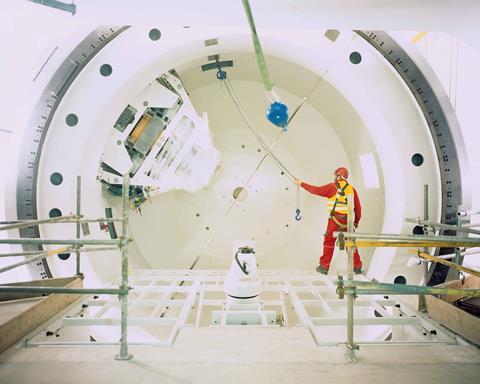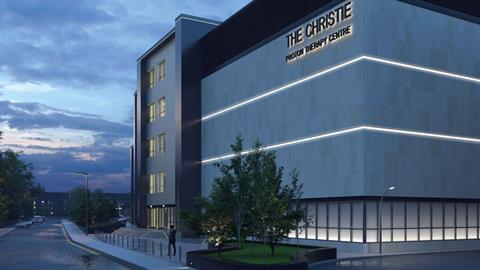The NHS’ first high-energy proton beam cancer treatment centre opens this summer at the Christie hospital in Manchester. Threading 10km of services pipework through 20,000m³ of concrete while avoiding the 1,700 tonnes of rebar embedded within it was just one of the many unusual challenges on the project

For most people in Britain, the first time they were ever likely to have heard of proton beam therapy was during the Ashya King controversy in 2014. Five-year old Ashya was suffering from a brain tumour but was removed from Southampton General Hospital without his doctors’ consent to receive experimental proton beam treatment in Prague. An international manhunt ensued before the Kings were arrested in Spain and extradited back to the UK.
Beyond the sad personal crisis for the King family, the case served to bring to public attention a radical and highly sophisticated form of cancer treatment that at the time was unavailable in this country. But now, four years later, two new proton beam treatments centres are being built in the UK, one at University College Hospital London and the other at the Christie hospital in Manchester.
Each centre costs around £130m and both are being entirely funded by the NHS. It is Christie’s that is set to open first this summer and when it does, not only will it be the first proton beam facility in the UK but it aims to be the most advanced and sophisticated version of only a handful of proton beam treatment centres around the world (including the one in Prague where Ashya eventually received his treatment).
Fittingly, the building’s list of technical features is almost as extraordinary as proton beam treatment itself. To meet the building’s gigantic energy load a new sub-station was built, which provides an equivalent amount of power to that needed to run the nearby Trafford Industrial Park. To contain the radiation, the concrete walls are up to 6m thick. Consequently, despite being just three storeys high, the building comprises an incredible 20,000m³ of concrete with 1,700 tonnes of reinforcement provided by steel rebar up to 100mm thick. Through this, 10km of services pipework has been carefully embedded. The concrete itself weighs 48,000 tonnes, the equivalent of two aircraft carriers.

However, this remarkable amount of concrete is not solely in place to contain the radiation, it is also there to support the four gigantic pieces of machinery around which the building is built. Three of these are rotating cylindrical chambers known as gantries and they are 10m in diameter and weigh around 180 tonnes. And while the particle accelerator where the proton beams are actually generated is only 4m high, at around 280 tonnes it weighs roughly the same as a Boeing 747. To put this into perspective, MRI scanners can weigh as little as 4 tonnes and as they emit no radiation require no surfeit of concrete. Equally, CT and X-ray scanners, which use photon cells, require only standard-density concrete approximately 100mm thick in order to provide effective shielding from radiation.

Of the Christie facility’s total budget, £80m has been spent on construction while £50m has been allocated for the equipment alone. And the entire project had to be delivered while the wider hospital site was still operational.
The justification for this extraordinary collection of features and the key to understanding the building’s unique set of technical specifications is proton beam treatment itself. If ever any medical treatment sounded as if it were lifted from the pages of science fiction, it’s this. Today there are three main strategies for treating cancer: surgery, chemotherapy and radiotherapy. Radiotherapy uses photon cell radiation to kill cancer cells but its inexact level of exposure risks causing damage to healthy tissue around the tumour which can potentially lead to health complications and negative side effects.
However, proton beam therapy can more precisely concentrate the area of radiation to the tumour in question. It allows for radiation to be meticulously adjusted to a precise breadth and depth across and within the body that exclusively targets cancerous cells. Such accuracy is particularly welcome in children, whose organs are more susceptible to damage as they are still growing.

Two-thirds the speed of light
The treatment works by a particle accelerator known as a cyclotron, stripping hydrogen gas atoms of their electrons to create charged, high-energy sub-atomic particles (protons). These protons are then injected into a vacuum chamber at the centre of the cyclotron. Here a strong, oscillating magnetic field accelerates the protons to two-thirds the speed of light. These protons are then ejected into a vacuum tube system surrounded by scores of additional magnets. These magnets can then adjust the speed and energy of the protons to the desired level. The vacuum tube system then leads to a gantry where the specified dosage of
















